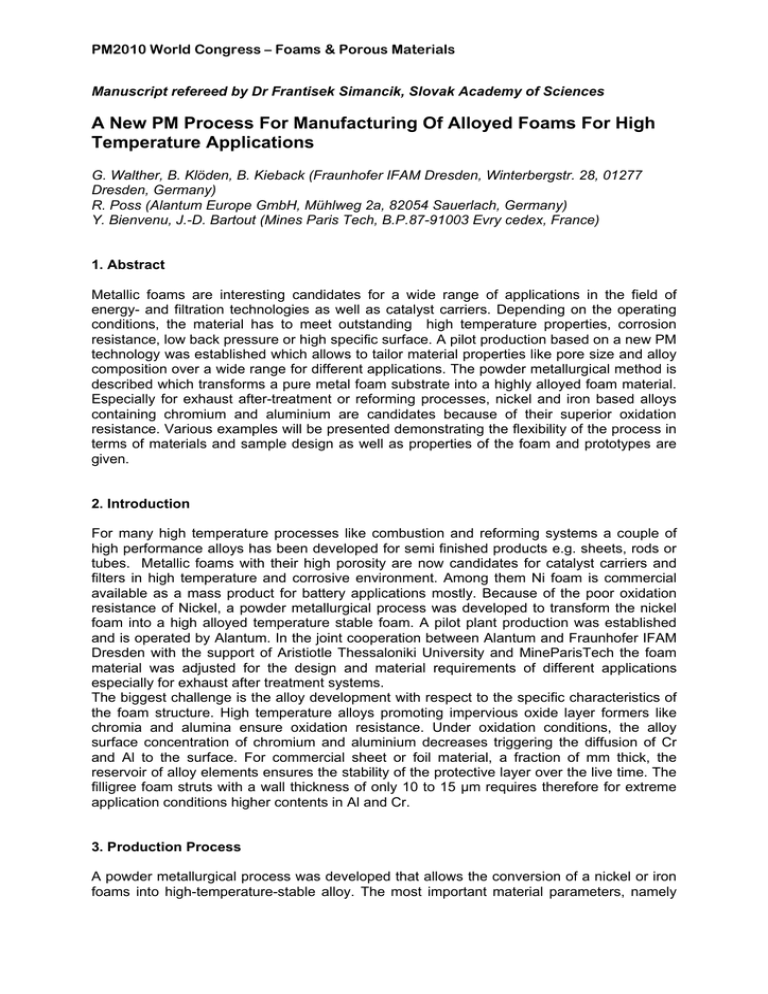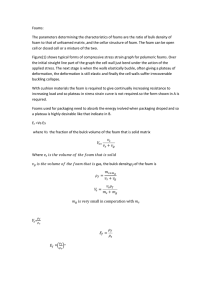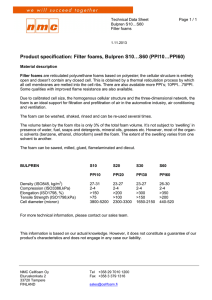A New PM Process For Manufacturing of Alloyed
advertisement

PM2010 World Congress – Foams & Porous Materials Manuscript refereed by Dr Frantisek Simancik, Slovak Academy of Sciences A New PM Process For Manufacturing Of Alloyed Foams For High Temperature Applications G. Walther, B. Klöden, B. Kieback (Fraunhofer IFAM Dresden, Winterbergstr. 28, 01277 Dresden, Germany) R. Poss (Alantum Europe GmbH, Mühlweg 2a, 82054 Sauerlach, Germany) Y. Bienvenu, J.-D. Bartout (Mines Paris Tech, B.P.87-91003 Evry cedex, France) 1. Abstract Metallic foams are interesting candidates for a wide range of applications in the field of energy- and filtration technologies as well as catalyst carriers. Depending on the operating conditions, the material has to meet outstanding high temperature properties, corrosion resistance, low back pressure or high specific surface. A pilot production based on a new PM technology was established which allows to tailor material properties like pore size and alloy composition over a wide range for different applications. The powder metallurgical method is described which transforms a pure metal foam substrate into a highly alloyed foam material. Especially for exhaust after-treatment or reforming processes, nickel and iron based alloys containing chromium and aluminium are candidates because of their superior oxidation resistance. Various examples will be presented demonstrating the flexibility of the process in terms of materials and sample design as well as properties of the foam and prototypes are given. 2. Introduction For many high temperature processes like combustion and reforming systems a couple of high performance alloys has been developed for semi finished products e.g. sheets, rods or tubes. Metallic foams with their high porosity are now candidates for catalyst carriers and filters in high temperature and corrosive environment. Among them Ni foam is commercial available as a mass product for battery applications mostly. Because of the poor oxidation resistance of Nickel, a powder metallurgical process was developed to transform the nickel foam into a high alloyed temperature stable foam. A pilot plant production was established and is operated by Alantum. In the joint cooperation between Alantum and Fraunhofer IFAM Dresden with the support of Aristiotle Thessaloniki University and MineParisTech the foam material was adjusted for the design and material requirements of different applications especially for exhaust after treatment systems. The biggest challenge is the alloy development with respect to the specific characteristics of the foam structure. High temperature alloys promoting impervious oxide layer formers like chromia and alumina ensure oxidation resistance. Under oxidation conditions, the alloy surface concentration of chromium and aluminium decreases triggering the diffusion of Cr and Al to the surface. For commercial sheet or foil material, a fraction of mm thick, the reservoir of alloy elements ensures the stability of the protective layer over the live time. The filligree foam struts with a wall thickness of only 10 to 15 µm requires therefore for extreme application conditions higher contents in Al and Cr. 3. Production Process A powder metallurgical process was developed that allows the conversion of a nickel or iron foams into high-temperature-stable alloy. The most important material parameters, namely PM2010 World Congress – Foams & Porous Materials the final composition, the specific surface area and the pore size of the foam can be varied in order to achieve optimum flexibility for the respective applications. Figure 1 shows the patented manufacturing process [1-6]. The nickel or iron foam is continuously unwound, coated first with a binder solution using a spraying technique and then with a high alloyed powder. Afterwards the foam is cut into sheets of the desired size. The following heat treatment includes a debindering and sintering step in which the elements from the powder diffuse into the foam struts and ensure a homogeneous alloy foam composition. Figure 1. Manufacturing process for alloyed Figure 2: Schematic illustration of processes Ni-based foam (schematic) occurring during transient liquid phase sintering with increasing temperature/time Microscopy images show a comparison of the pure Ni foam vs. alloyed foam in figure 3. The high roughness of the alloyed foam offers a number of advantages, including high specific surface and good adhesion of catalytic coatings as well as good gas conversion efficiency for catalysts which are described in the sections to follow. a) b) Figure 3. SEM images of (a) pure Ni foam and (b) alloyed foam 4. Foam Alloys and Properties 4. 1 General Properties The main features of the available foam qualities are summarized in table 1. The density of the alloyed foam is low with values between 0,41 and 0,72 g/cm³, which offers a high potential for lightweight metallic structures. There is a wide range of pore sizes and alloys available, allowing filtration characteristics like pressure drop or filtration efficiency to be adapted to the respective applications. The thickness can be increased substantially by PM2010 World Congress – Foams & Porous Materials sintering a stack of foams together allowing the manufacturing of geometries like cylinders or cuboids. The process is very flexible with respect to the metal composition, because a wide variety of metal powders can be used (more than 40 different compositions were tested successfully). The high workability of the Ni or Iron foam allows it to be manufactured to the final geometry of the component after application of the coating, before the sintering stage. In this way complex components made of materials that are difficult to work are also easy to manufacture. Pore size [µm] 450 580 800 1200 density (g/cm³) 0,72 0,60 0,48 0,41 alloyed foam thickness porosity (mm) (%) 1,60 > 92% 1,90 2,50 3,00 alloys Inconel ® type, Monel ®, NiAl, NiAlCr, NiFeAlCr, FeCrAl Table 1: Available foam qualities and alloys 4.2 High Temperature Oxidation Resistance One promising field of application are components for exhaust aftertreatment systems e.g. diesel particle filters (DPF), diesel oxidation catalysts (DPF) and SCR catalysts (SCR – selective catalyst reaction) for the automotive and offroad industry. To examine the high temperature corrosion resistance the samples were tested in a tube furnace at 700, 800, 900 and 1000 °C in a diesel exhaust atmosphere (12%CO2, 10%H2O, 6%O2, 200 ppm SO2, balance N2). The duration of the tests was 10, 30, and 100 hours. Before the tests the samples were cleaned in an ethanol ultrasonic bath, dried and weighted. The furnace was heated up in argon and the samples were put into the hot furnace on a quartz crucible. After the test the samples were weighted again after cooling which indicates the oxidation rate. Under 700 and 800°C the weight gain is marginal for the different sample qualities. Therefore the discussion will be focused on the oxidation tests at 900 and 1000°C (figure 5 and 6). The high operation temperatures up to 1000 °C and the compatibility with catalytic coatings (wash coat) needed special alloy composition and pre-treatment of the material. NiFeCrAl and FeCrAl alloys are promising candidates in terms of oxidation resistance because of its aluminium content, which enables the alloy to form an alumina layer and ensures a long-term oxidation resistance at temperatures > 950°C [7, 8]. Chromium supports the alumina scale formation on the surface because it prevents the internal oxidation before the alumina layer is established [9]. Furthermore under nitrogen containing atmospheres at high temperatures without a dense alumina scale nitride formation is observed for commercially used alumina formers like FeCrAl and NiCrAl [10]. In this case aluminium would be consumed near the surface which would result in a weak alumina scale formation and a less oxidation resistance. A further problem is the wash coat aging, which is caused by chromium migration into the catalytic material. As an effective diffusion barrier ∀-alumina is identified. Such a layer must be formed under well defined conditions [11, 12], because its homogeneity and its existence prior application under operation conditions determinates the durability of the material system. For the first based on a Ni foam substrate developed NiFe22Cr22Al6 alloy a special preoxidation regime needed to evaluate. The high Ni content in that alloy is responsible for the (structure and therefore low diffusion speed of aluminum to the surface to form a oxide layer before other metals of the alloy especially chromium is oxidized which is harmful to the catalytic layer and homogeneity of the alumina scale. Knowing the metal/metal oxide equilibriums of the different alloy components in figure 4 the formation of undesired oxides can be suppressed. The solution was a hydrogen atmosphere with an oxygen partial PM2010 World Congress – Foams & Porous Materials pressure p(O2) above chromium/chromia. the equilibrium aluminium/alumina but below to that of oxygen partial pressure below this line no chromia formation = pure alumina for NiFeCrAl alloy temperature Figure 4: Equilibrium lines for metal oxide formation subject to temperature and oxygen partial pressure p(O2) Examination in Diesel Exhaust Gas at 900°C Examination in Diesel Exhaust Gas at 1000°C 10 9 NiFeCrAl - pre-ox. low p(O2) NiFeCrAl as sintered 8 9 NiFeCrAl pre-ox air NiFeCrAl - pre-ox. low p(O2) 7 m a s s c h a n g e in % m a s s c h a n g e in % FeCrAl as sintered 6 FeCrAl pre-ox. air 8 FeCrAl pre-ox. air 5 4 3 2 7 6 5 4 3 2 1 1 0 0 0 10 20 30 40 50 60 70 80 90 100 110 time in h Figure 5: Mass gains of sintered and preoxidized NiFeCrAl and FeCrAl alloys under diesel exhaust atmosphere at 900°C after 10, 30, 100h (source: Dechema, Frankfurt) 0 10 20 30 40 50 60 70 80 90 100 110 time in h Figure 6: Mass gains of sintered and preoxidized NiFeCrAl and FeCrAl alloys under diesel exhaust atmosphere at 1000°C after 10, 30, 100h (source: Dechema, Frankfurt) It can be seen in figure 5 that compared to the only sintered (not pre-oxidized) NiFeCrAl sample the amount of oxidation can be considerably reduced by pre-oxidizing under low oxygen partial pressure more effective than by pre-oxidizing under air. A further development aimed to a high temperature alloy like FeCr22Al6 alloys which could be more efficient pre-oxidized using a conventional air furnace. For that Fe foam precursers are needed for large scale production similar to that of the commercial Ni foam. This process is currently ongoing to be established. First prototypes were coated by the available coating and alloying process (described in chapter 3). The pre-oxidation regime under air was evaluated. Because of the ∀-structure of the FeCrAl the diffusion speed of the aluminium is higher than in the (-matrix of NiFeCrAl and the alumina layer is established prior the oxidation of iron or chromium also under the high oxygen partial pressure of the air atmosphere. The protection of the formed oxide scale is demonstrated in the much lower weight gain of the pre-oxidized sample compared to its sintered state at 900°C (figure 5). PM2010 World Congress – Foams & Porous Materials Both alloy foams the NiFeCrAl and the FeCrAl have outstanding high temperature properties. This is shown in a diesel exhaust test at 1000°C however the weight gain of the NiFeCrAl alloy is higher compared to FeCrAl. The SEM micrographs (SEM = scanning electron microscope) and electron probe microanalysis (EPMA) in figure 7 a), b), and 8 a), b) demonstrating a homogeneously formed alumina layer and no internal oxidation or nitrating of the strut material. A comparison of the distribution maps of oxygen and aluminium in the figures 7b) an 8b) shows that the pre-oxidation has obviously formed a layer of alumina on the strut surface which is stable also after exposure for 100 h at 1000 °C under diesel exhaust. Looking at the NiFeCrAl micrograph in figure 7 on the inside strut surface a mixed oxide layer (chromia, alumina. nickel oxide, iron oxide) has formed above the alumina layer likely as a result of not fully pre-oxidation in this area. This fact can explain the higher weight gain of the sample at 1000 °C compared to FeCrAl (figure 6). However the protection of the alumina scale is high enough for an outstanding durability at such high temperatures. (a) (b) Figure 7: BSE image (left) and element distribution maps (right) of the sample NiFe22Cr22Al6 pre-oxidized under air, oxidized in diesel exhaust at 1000°C for 100h (a) (b) Figure 8: BSE image (a) and element distribution maps (b) of the sample Fe14 pre-oxidized under air, oxidized in Diesel exhaust at 1000°C for 100h PM2010 World Congress – Foams & Porous Materials 5. Applications In contrast with current market standard substrates the alloy foam sheet material has a very high design flexibility. It can be cut at any length, rolled, stacked, bent, and shaped, for example. It is also possible to sinter the material, usually manufactured as sheets, into stacks during the production process and to subsequently cut these. Even very complex structures can be manufactured in this way. Figure 9 shows a design study of a foam diese oxidation catalysts. Foam DOC’s were manufactured with different designs and tested on a engine test bench under the european driving cycle compared to a state of the art DOC. Using a foam DOC over 30% less hydrocarbon and NOx emission was measured with a comparable catalyst volume and wash coat loading. The reason is a higher turbulent flow caracteristics because of the irregular foam structure and therefore more intensive gas reaction with the catalyst [13, 14]. This results in a 30 % saving of precious metal and reduces the component cost considerably. Figure 10 shows the potential of the foam DOC concerning soot particle reduction. It’s with over 20% particle mass reduction two times higher than that of the ceramic DOC. This offers the high potential to integrate a DPF function into the DOC with passive regeneration. With such concept the enclosed DPF has to be less active regeneration cycles which would enlarge the filter life time and also reduce the fuel consumption because the active regeneration is managed by additional fuel injection to increase the exhaust temperature. Particle Mass Reduction in the European Driving Cycle Partikelreduction [%] 25 20 15 10 5 0 DOC 2 (ceramic, state of the art) DOC 5 (foam design 5) DOC Nr. Figure 9: Foam diesel oxidation catalyst (DOC), - Alantum Design 6: conical channels, ring type Figure 10: Particle reduction of foam DOC compared to a state of the art ceramic DOC Another application is for heavy duty trucks. A filter for a 12 liter diesel engine was developed using the foam to reduce the pollutant category of heavy duty trucks from EURO III to EURO IV which is shown in Figure 9. The certification is presently running. Figure 9: Foam DPF for heavy duty trucks to reduce the pollutant category from EURO III to EURO IV PM2010 World Congress – Foams & Porous Materials 6. Summary A powder metallurgical process was developed allowing the transformation of nickel and iron foam into a high temperature and corrosion resistant alloy foam. This technology is cost efficient and suitable for a large scale production. Parameters such as pore size and alloy composition as well as the foam design can be varied for the respective operation conditions. It was shown that for the high temperature oxidation resistance the establishing of an alumina layer on the foam surface by a heat treatment increases considerably the material life time. This innovative foam material has not only a high potential for automotive exhaust aftertreatment systems but also for catalyst applications in reforming processes, as electrode material in fuel cells and supercapacitors and noise absorption. 7. Literature [1] A. Böhm, H. Goehler, D. Naumann. German patent, DE 101 50 948 C1, 2003 [2] G. Walther, A. Böhm, Th. Weißgärber, H.-D. Böhm, B. Engelmann, D. Naumann. German patent, DE 103 16 929 B3, 2005, European patent EP 1 620 370 B1, 2006 [3] A. Böhm, G. Walther, D. Naumann, L. Timberg. German patent, DE 10 2004 014 076 B3, 2005 [4] A. Böhm, G. Walther, D. Naumann. German Patent, DE 103 46 281 B4, 2006, World Patent, WO 2005/037467 A2, 2005 [5] A. Böhm, G. Walther, D. Naumann, L. Timberg. German patent, DE 10 2005 010 248 B4, 2006 [6] A. Böhm, G. Walther, D. Naumann. German patent, DE 10 2004 032 089 B3, 2005 [7] R. Bürgel, “Handbook High Temperature Materials”, Braunschweig/Wiesbaden, Vieweg & Sohn, 1998, 352-388 [8] J. Huang, H. Fang, X. Fu, F. Huang, H. Wan, Q. of Metals”, 2000, 53, 273 [9] W. J. Quadakkers, “Fundamentals of Oxidation of Alloys”, DGM workshop, Research Centre Jülich, 2006 [10] B. A. Pint, J. R. Regina, K. Prüßner, L.D. Chitwood, K.B. Alexander, P.F. Tortorelli, “Effect of environment on the oxidation of ingotprocessed iron aluminides”, Elsevier, 2001 [11] A. Galerie, Y.Wouters and M. Caillet, “The kinetic behaviour of metals in water vapour at high temperature: Can general rules be proposed?”, in High temperature corrosion of metals, R. Streiff et col. ed., Mater. Sci. Forum 369-372, Transtech Publications (2001), p 231, [12] H. Gotlind, F.Liu, J.E. Svensson, M. Halversson and L.G. Johansson, “The effect of water vapour on the initial stages of oxidation of FeCrAl alloy Kanthal AF at 900°C”, Oxidation of metals, Vol 67, 5-6, June 2007, pp 251-266. Zhang, S. Deng, J. Zu, “Oxidation PM2010 World Congress – Foams & Porous Materials [13] G.C. Koltsakis, D. Katsaounis, Z. C. Samaras, D. Naumann, Sh. Saberi, A. Böhm, SAE paper 2006-01-1524, 2006 [14] G.C. Koltsakis, D. Katsaounis, I. Markomanolakis, Z. C. Samaras, D. Naumann, Sh. Saberi, A. Böhm, SAE Transactions: Journal of Fuels and Lubricants (2007-01-0659), 2007



